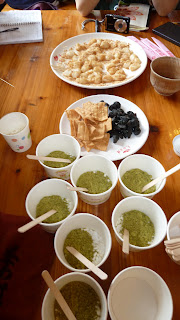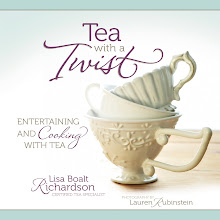Happy New Year, please join me as I continue my blog of my wonderful tea adventure to Taiwan and Japan!
After returning to Taipei about 11:00 p.m. from the our journey to the tea fields of central Taiwan, checking back into our hotel, and gathering our luggage that we left behind, we were all pretty tired. Our next day started a little later as we were traveling close by. Our first stop was this lovely little town just about an hour away. The town had a scenic river running right through it.
We toured of factory that supplies tea for an international company that is known around the world. Due to confidentiality, I cannot share the name of the company which is disappointing! What struck me was how immaculately clean the facility was. Can you see the floors are stainless steel? I hadn't ever seen that before and was wondering how I might install that somewhere in my house! Some tea was in the baskets to the right withering and to the left were bags full of tea ready to be sent off.
 After touring the plant, we walked out to see some of the gardens. Here is Jackson Huang talking with one of the tea farmers. I would have brought back one of those straw hats if I could have figured out how to get it back without crushing it. I think it would have been fun to hang it in my office!
After touring the plant, we walked out to see some of the gardens. Here is Jackson Huang talking with one of the tea farmers. I would have brought back one of those straw hats if I could have figured out how to get it back without crushing it. I think it would have been fun to hang it in my office! The rest of the day was for shopping in Yinge, which is a ceramic town that specializes in tea sets that harmonize well with Taiwan oolongs. Some of group shopped for their stores, but since I don't owe a tea shop, I was shopping just for myself and gifts for others. Here is my Christmas present to myself. It is a handmade piece that over time will take on a crackled look. I LOVE it!
The rest of the day was for shopping in Yinge, which is a ceramic town that specializes in tea sets that harmonize well with Taiwan oolongs. Some of group shopped for their stores, but since I don't owe a tea shop, I was shopping just for myself and gifts for others. Here is my Christmas present to myself. It is a handmade piece that over time will take on a crackled look. I LOVE it! Our next day was filled with more learning experiences. We headed to the Oriental Beauty district. Our first stop was to a museum to learn about this area and tea farming. This part of Taiwan was settled by the Hakka people which is a subgroup of the Chinese with their own linguistic dialect. Our guides Thomas and Josephine happen to be Hakka, so it was fun at the end of our museum tour to make a traditional Hakka snack.
 It starts with sesame seeds, black and white peanuts, and pumpkin seeds that are ground up into a paste. We were shown how to use this large "mortal and pestle" type system for grinding it all up. It required some elbow grease for sure. It tasted quite good all on its own.
It starts with sesame seeds, black and white peanuts, and pumpkin seeds that are ground up into a paste. We were shown how to use this large "mortal and pestle" type system for grinding it all up. It required some elbow grease for sure. It tasted quite good all on its own. After it was all ground up into a paste, we spooned it into cups that contained green tea powder and puffed rice. Hot water was added to it for a Hakka "protein/energy" drink! There were also a few other snacks as you can see!
After it was all ground up into a paste, we spooned it into cups that contained green tea powder and puffed rice. Hot water was added to it for a Hakka "protein/energy" drink! There were also a few other snacks as you can see! 
Probably the most intriguing thing to this area is the Fancy Formosa Silver Tip tea. Its wonderful and unique flavor is contributed to the leaf hopper. It is a small little bug that eats the leaves of the tea plant during a specific period in the summer. Seen below on a Camellia Sinensis plant, this small bug has a huge impact on flavor!
While the farmers are busy with their other crops, this bug infests the tea plants. This attack makes the plant respond with a chemical defense to help it repel the insect and protect itself. As I learned in my last Specialty Tea Institute Level 4 Technology of Tea class, that this stress to the tea plant is known as a physical biotic stress. The compound that the plant produces to rid itself of the bugs actually changes the flavor of the leaves to a wonderfully unique brew. Now how cool is that?
Our next stop was to visit Mr. Lou who is the head of The Formosa Black Tea Company. We all felt famous as we stepped off the bus to a camera crew filming our visit.
We watched an informative film and toured the facility which has a lovely display of the history of the company. What I thought was very interesting is the way Mr. Lou and his company has kept up with the demand for tea and changed its ways depending on what the market is demanding. His company is now a large supplier of green tea powder to Japan for beauty and cosmetic products. If you have beauty products that contain green tea-it might just be from The Formosa Black Tea Company! I was honored to meet Mr. Lou seen below.
Our final event of the day was the Grand Cupping. It was set up by Norman Shu of ABC Tea Company. We cupped (professional way to taste tea) about 30 different type of teas. It was the biggest cupping I had ever done at one time.
Join me for the next blog as I take you to our closing ceremony. Then I have my own Planes, Trains, and Automobiles experience to Japan! I hope you can keep journeying with me to Japan.
Is there anything new you learned through my blog? I would love to hear!
Happy Sharing Taiwan and Sipping Oolong, Lisa





















Loved reading about the bug!
ReplyDeleteHi Lady Katherine, glad you liked it!
ReplyDeleteHi Lisa, as you say it’s pretty cool that a Bug indirectly changes the flavor of the tea, but nature is such causing subtle tweaks. I am wondering if you have tried the same bug assisted tea without the bugs. If so, is the tea just different or just not nice tea.
ReplyDeleteRegards Damian Black
Wow, I never knew about the bug, either. how jealous I am of your wonderful (and interesting) trip!
ReplyDeleteDearest Lisa,
ReplyDeleteAs microbiologists, we are not in agreement with the story about the leaf hopper. You write that at a specific time in the summer, this little bug eats the leaves. Well, then this would hamper the harvest of tea leaves.
Secondly, the response by the tea plant in a way of chemical defense to repel the bug is not what we know about this type of tea.
The leaf hopper, in the summer, transfers flower pollen to the tea leaves, adding a unique honey flavor. The production method of rolling and baking those summer harvest tea leaves (e.g. named Silver Tip Oolong) leaves little kernels of tea that burst open. Hence its unique very strong honey taste.
Looking forward to your Japan trip!
Lots of love,
Mariette
I am following up from Mariette's comment. I have done more research on this to varify all of this. I was wrong in the fact that the insect does not eat the leaf, but just suck
ReplyDeletethe juice of the tender leaf and forces the leaf to stop growing larger. This however doesn't kill the leaf, but the leaf stops growing and remains at that stage. This does change the leaf's chemistry by going into defense mode.
Here is the following information straight from researchers in Taiwan:
"The occurrence mechanism of honey flavor of white tip Oolong tea is still unclear. According to Mr. Tseng, whose major study is tea pest & disease research, the occurrence mechanism of honey flavor of white tip oolong tea might be:
(1) as a result of the saliva of green leafhopper,
(2) as a result of the saliva of green leafhopper combine with the secretions of tea plant when its tip was sucked by this insect,
(3) as a result of chemical communication between tea plant-herbivore-natural enemies (Most of the related papers in Taiwan & China discuss this hypothesis."
I apologize for saying the bug ate the leaf as I had been told. However, the rest of the information is accurate!